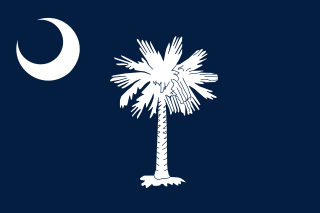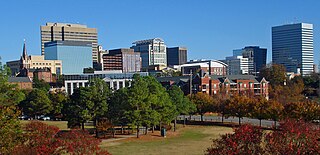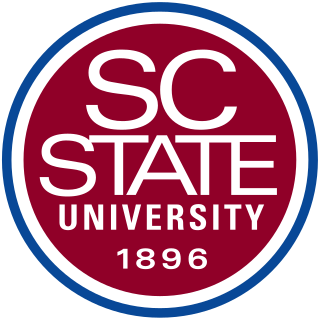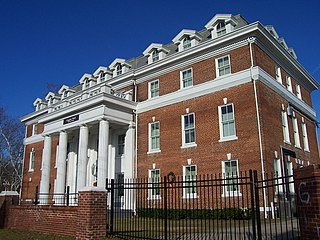
South Carolina is a state in the coastal Southeastern region of the United States. It is bordered to the north by North Carolina, to the southeast by the Atlantic Ocean, and to the southwest by Georgia across the Savannah River. South Carolina is the 40th most extensive and 23rd most populous U.S. state with a recorded population of 5,124,712 according to the 2020 census. In 2019, its GDP was $213.45 billion. South Carolina is composed of 46 counties. The capital is Columbia with a population of 137,300 in 2020; while its largest city is Charleston with a 2020 population of 150,277. The Greenville–Spartanburg-Anderson metropolitan area is the most populous in the state, with a 2020 population estimate of 1,455,892.

Columbia is the capital of the U.S. state of South Carolina. With a population of 136,632 at the 2020 census, it is the second-largest city in South Carolina. The city serves as the county seat of Richland County, and a portion of the city extends into neighboring Lexington County. It is the center of the Columbia metropolitan statistical area, which had a population of 829,470 in 2020 and is the 72nd-largest metropolitan statistical area in the nation. The name Columbia is a poetic term used for the United States, derived from the name of Christopher Columbus, who explored for the Spanish Crown. Columbia is often abbreviated as Cola, leading to its nickname as "Soda City."

Aiken is the largest city in, and the county seat of, Aiken County, in western South Carolina. It is one of the two largest cities of the Central Savannah River Area. Founded in 1835, Aiken was named after William Aiken, the president of the South Carolina Railroad. It became part of Aiken County when the county was formed in 1871 from parts of Orangeburg, Lexington, Edgefield, and Barnwell counties.

Orangeburg, also known as The Garden City, is the principal city in and the county seat of Orangeburg County, South Carolina, United States. The population of the city was 13,964 according to the 2010 United States Census and declined to 12,704 in the 2020 census. The city is located 37 miles southeast of Columbia, on the north fork of the Edisto River.

Batesburg-Leesville is a town located in Lexington and Saluda counties, South Carolina, United States. The town's population was 5,362 as of the 2010 census and an estimated 5,415 in 2019.

South Carolina State University is a public, historically black, land-grant university in Orangeburg, South Carolina. It is the only public, historically black land-grant institution in South Carolina, is a member-school of the Thurgood Marshall College Fund, and is accredited by the Southern Association of Colleges and Schools (SACS).

Logan Circle is a historic roundabout park and neighborhood of Washington, D.C., located in Northwest. The majority of Logan Circle is primarily residential, except for the highly-commercialized 14th Street corridor that passes through the western part of the neighborhood. In the 21st century, Logan Circle has been the focus of urban redevelopment and become one of Washington's most expensive neighborhoods. Today, Logan Circle is home to one of the D.C.'s most prominent gay neighborhoods.

Allen University is a private historically black university in Columbia, South Carolina. It has more than 600 students and still serves a predominantly Black constituency. The campus is listed on the National Register of Historic Places as Allen University Historic District.

The Old Campus District, University of South Carolina, is a historic district centered on The Horseshoe on the main campus of the University of South Carolina in Columbia, South Carolina. On June 5, 1970, it was listed in the National Register of Historic Places. On April 19, 1996 MTV Unplugged filmed Hootie & the Blowfish's concert on The Horseshoe before the release of their second album Fairweather Johnson.
William Augustus Edwards, also known as William A. Edwards was an Atlanta-based American architect renowned for the educational buildings, courthouses and other public and private buildings that he designed in Florida, Georgia and his native South Carolina. More than 25 of his works have been listed on the National Register of Historic Places.

The McMaster School, built in 1911, is an historic building located at 1106 Pickens Street on the corner of Senate Street in Columbia, South Carolina. It was designed by noted Columbia architect William Augustus Edwards of the firm of Edwards and Walter. Edwards and his partner, Frank C. Walter, designed sixteen schools according to standardized guidelines established by the state legislature in 1905. The architects chose a Renaissance Revival style with H-shaped floor plans used as the standard for the state in buildings designed and constructed by other architects. The State newspaper declared it the "handsomest school building in Columbia" when it opened in 1911.

Booker T. Washington High School, named for the famous educator, opened in September 1924 under the auspices of the Atlanta Board of Education, with the late Charles Lincoln Harper as principal. It was the first public high school for African-Americans in the state of Georgia and the Atlanta Public Schools system.
Esau Jenkins was a South Carolina African-American Human Rights leader, businessman, local preacher, and community organizer. He was the founder and leader of many organizations and institutions which helped improved the political, educational, housing, health and economic conditions of Sea Island residents.

The Hampton–Preston House located at 1615 Blanding Street in Columbia, South Carolina, is a historic mansion that was the home of members of the prominent Hampton family. It was listed in the National Register of Historic Places on July 29, 1969.

Edward Culliatt Jones was an American architect from Charleston, South Carolina. A number of his works are listed on the U.S. National Register of Historic Places, and two are further designated as U.S. National Historic Landmarks. His works include the following :
Woodruff High School is a public secondary school in Woodruff, South Carolina, United States, and is the only high school in Spartanburg County School District 4.
The following is a timeline of the history of the city of Columbia, South Carolina, USA.
William "Beverly" Nash was a barber, shoe shine, porter, waiter, and state senator in South Carolina. An African American, Nash was born enslaved in Virginia, Nash gained his freedom at the age of 43 with the passage of the 13th Amendment. After the Civil War he became a state legislator during the Reconstruction Era. He was instrumental in drafting South Carolina's Constitution of 1868, and held several committee positions in the state government over his career. He held his office for 21 years before resigning.

The South Carolina State Library (SCSL) is the official State Library of South Carolina located in Columbia, South Carolina. It is both a library and a state agency. The SCSL manages public library development, federal and state funding for libraries, service for print-disabled and physically handicapped patrons, library service for state institutions, and library service to state government agencies.















